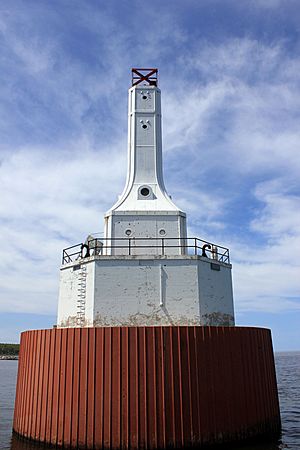Keweenaw Waterway Upper Entrance Light facts for kids
 |
|
|
|
|
| Location | E. breakwater Keweenaw Waterway, N. end, .4 mi. offshore, Hancock Township, Michigan |
|---|---|
| Coordinates | 47°14′4″N 88°37′49″W / 47.23444°N 88.63028°W |
| Year first constructed | 1950 |
| Year first lit | 1950 |
| Automated | 1970s |
| Foundation | crib |
| Construction | steel tower |
| Tower shape | square tower on cylindrical base |
| Markings / pattern | white |
| Height | Tower - 70 feet (21 m) |
| Focal height | 82 feet (25 m) |
| Original lens | VRB-25 marine beacon. |
| Range | 15 nautical miles (28 km; 17 mi) |
| Characteristic | Fl White, 15 sec |
| ARLHS number | USA-419 |
| USCG number | USCG 15120 |
The Keweenaw Waterway Upper Entrance Light is a lighthouse in Michigan. You can find it at the north end of the Portage River. It's located inside McLain State Park in Hancock Township, Michigan. This important lighthouse was added to the National Register of Historic Places in 2014.
Contents
History of the Lighthouse
The Portage River was first dug deeper, or dredged, in 1860. Soon, people realized a light was needed to guide boats into the waterway.
Early Lights and Improvements
In 1873, the U.S. Congress set aside money to build a lighthouse here. The first lighthouse was built in 1874 on a nearby hill. To make the waterway better, two long structures called piers were built into Lake Superior. These piers helped protect the canal's entrance.
In 1879, a wooden tower was built on the pier. Later, in 1887, a loud steam fog signal was added to help boats in foggy weather. The U.S. government bought the canal in 1891 and started making many improvements. The light at the end of the pier was greatly updated in 1895.
New Breakwaters and Modernization
In 1901, large walls called breakwaters were added to protect the entrance from waves. By 1903, the ends of these breakwaters had their own pyramid-shaped lighthouses.
In the 1930s, the U.S. Army Corps of Engineers began a big project. They wanted to make the canal much wider. As part of this work, the old brick lighthouse from 1874 was taken down. A new tower replaced it in 1937.
The widening project finished in 1949. This work changed where the breakwaters were at the canal's mouth. Because of this, the 1903 lights had to be removed. In 1950, the lighthouse you see today was built. It stands on the eastern breakwater. The light was made automatic in the 1970s, meaning it no longer needed a person to operate it.
About the Lighthouse Structure
The Keweenaw Waterway Upper Entrance Light is built on a strong base. This base is a round structure called a caisson. It's made of steel and filled with rocks.
Foundation and Building Design
The caisson is about 50 feet wide and 45 feet tall. It's built from steel sheets that lock together. The top of the caisson has a concrete deck, which is about 15 feet above the lake's surface.
On top of this deck is an 11-foot-tall concrete building. This building is where the fog signal used to be. It's shaped like a rectangle with slightly cut corners and is painted white. There's a double-door entrance about two feet above the deck.
The Light Tower
Right in the middle of the fog signal building is the steel light tower. It has five stories and was designed in the 1930s. The bottom part of the tower is a rectangle with slightly cut corners, just like the building below it.
Above this, the tower's four sides curve inward and upward. This creates a tall, narrow rectangular shape. The upper parts of the tower have small round windows called port lights. The very top of the tower has a flat roof. On this roof sits an open-air VRB-25 marine beacon, which is the light that guides ships. The tower's design shows elements of the Streamlined Moderne style, which was popular in the 1930s.


